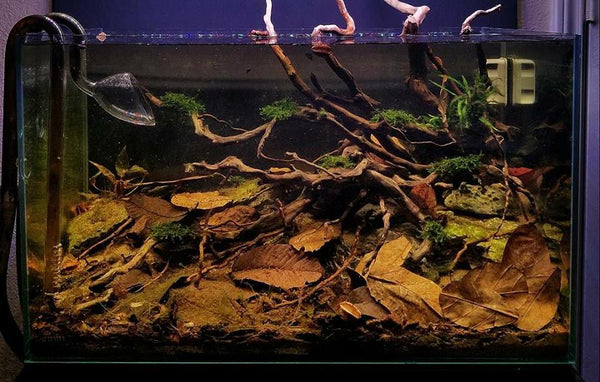- Continue Shopping
- Your Cart is Empty
Old ideas. New obsessions. A "Lesson from a Leaf?"
One of the most enjoyable things about our blackwater, botanical-style aquarium obsession is that you can try so many different things and create completely different looks, environmental conditions, and potential outcomes by merely changing stuff up a bit.
As one of those who is knee-deep in the business of bringing all sorts of new and different botanicals to market (someone called me "The Podfather", lol), I am in the unique position of being able to test everything that I offer. Not only is this a responsibility that I happily bear, it's a helluva lot of fun, too!
Now, there are many, many botanicals which I've worked with that, for one reason or another, don't "speak to me" and will likely never end up being a permanent part of any of my aquascapes. Some, like Alder Cones, Birch Cones, and Casuarina Cones, are purely "functional", in that they are utilized as "water conditioners" (sic) or "grazing vehicles for shrimps.
Not a part of any aquascape I would do.

Yeah, some of the stuff I offer will not end up in my tanks- at least, not where you can see them!
Or, will they?
My mind set has evolved somewhat.
A recent case in point: Our Texas Live Oak leaves, which I was alerted to by Cory Hopkins, have really captivated me of late. And apparently, many of you, too! And it's easy to see why: They are small, have a very interesting look, which makes them what I like to call "generic-tropical" in appearance.
This essentially means that, once submerged and in the 'scape with other leaves, they look more-or-less like "any old tropical leaf" you'd find in natural aquatic habitats.

That's a huge thing for me.
Like, have you noticed that I don't carry other types of Oak leaves, even though many are perfectly suitable for aquatic use? I have a lot of people who've offered to supply us with them, but keep passing. And it's part of my own mishegas (insanity). It's really because- well- this sounds kind of dumb, I suppose- they look too much like...Oak leaves! 😂
Yeah.
So that's like one of those things I consider. I mean, in the end, everything we toss in our tanks starts to break down, and ultimately you can't really tell that you're using a White Oak leaf from California in your Southeast Asian stream aquarium, but I have this weird mindset which tells me that can't start things that way, if you know what I mean?
Of course, I'm the guy who loves the decidedly-NOT-biotopically accurate Magnolia leaves, right? So there is some hope for me.
That's just me.
Plant of hobbyists do, with terrific results.

And I suppose, that's where I sometimes jump on the "biotope-purist" crowd a bit- like, really- you can tell exactly what leaf came from where once it's submerged and breaking down? And you're positive the leaves in that award-winning "Amazonian Igarape" tank are from the Amazon? Trust me, no vendor in the world has some of the leaves you'd see in say, the Amazonian region (I'm working on it, though!), so almost every leaf you see in even the most well-liked biotope aquarium is (usually) biotopically incorrect.

And there is absolutely nothing wrong with that, IMHO.

Oh, back to the Live Oak leaves...See, I got sidetracked again!
They are truly remarkable botanicals, in that they also tend to sink after jus ta few minutes of steeping in boiling water, last a long time submerged, and are the right "scale" for even smaller aquariums. When you combine them with Yellow Mangrove Leaves (one of my other more recent obsessions), they form the basis of a rather "exotic-looking", long-lasting, and "properly-proportioned" leaf litter bed!

And they add a wonderful tint to the water. All in all, a great leaf to use in almost any blackwater aquarium display.
See, this little leaves taught me a BIG lesson: Just about any botanicals that we work with can create some pretty incredible looks, if you give them a chance! Being open to working with different materials is a good thing!

And I think this has been instrumental in my evolution as an aquarist and aquascaper. Accepting the possibilities that each botanical offers; trying to utilize different botanicals for different looks has opened me up to all sorts of different experiences with my aquariums.
Stuff that definitely helps create aquariums which replicate, to some extent, the appearance and processes which occur in natural aquatic habitats.

The other thing that is fun is how just a simple tweak here or there- switching up a few types of leaves or botanicals- can create an entirely different type of aquarium. I can't tell you how many times that a hobbyist has approached me and told me that they wanted to try that new botanical, adding it to their tank, only to end up creating a completely different type of aquarium experience in the process!
Allow yourself the opportunity to indulge and create new obsessions!
THAT is pretty exciting to me!
Sooo...
Be open to trying just about anything that you find interesting. Enjoy the challenge of making "alien" materials work for the look you're trying to achieve in your tropical aquarium

Most important- stay open minded.
Stay creative. Stay excited. Stay innovative...
And Stay Wet.
Scott Fellman
Tannin Aquatics










Scott Fellman
Author